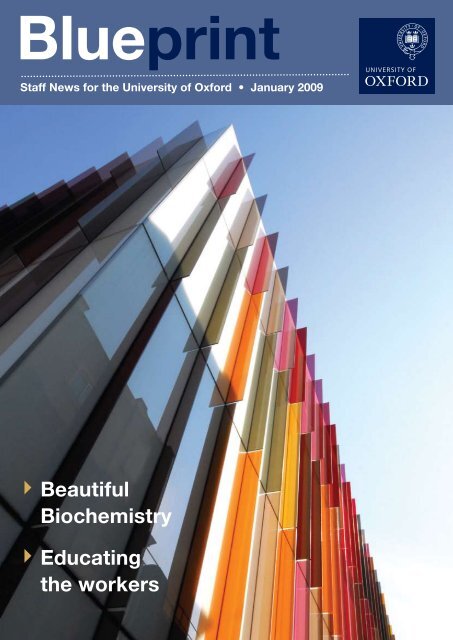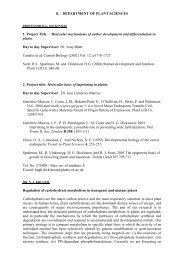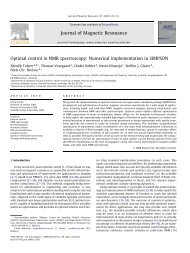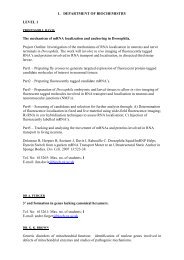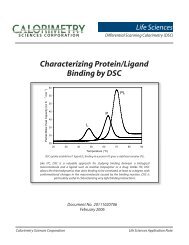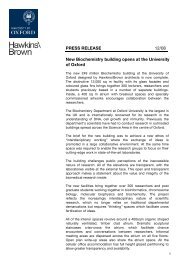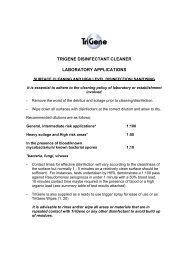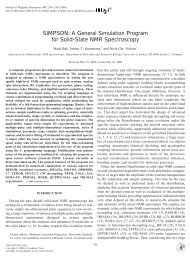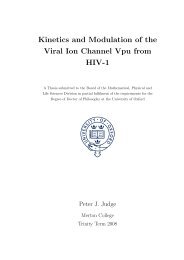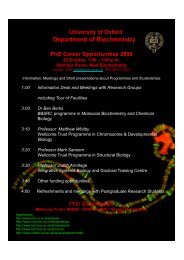Beautiful Biochemistry Educating the workers - Department of ...
Beautiful Biochemistry Educating the workers - Department of ...
Beautiful Biochemistry Educating the workers - Department of ...
You also want an ePaper? Increase the reach of your titles
YUMPU automatically turns print PDFs into web optimized ePapers that Google loves.
Blueprint<br />
Staff News for <strong>the</strong> University <strong>of</strong> Oxford • January 2009<br />
▸ <strong>Beautiful</strong><br />
<strong>Biochemistry</strong><br />
▸ <strong>Educating</strong><br />
<strong>the</strong> <strong>workers</strong>
Topfoto/John Timbers iStockphoto/Filo<br />
Phil Sayer<br />
news in brief<br />
Cover: <strong>Biochemistry</strong>’s<br />
spectacular new home (pp6–7)<br />
sports coloured glass fins <strong>of</strong><br />
different widths, giving <strong>the</strong><br />
building a curve and moving<br />
dimension that alters as you<br />
pass from east to west or<br />
west to east, and a different<br />
feel by day or night.<br />
Photo credit: Greg Smolonski<br />
▸▸Two new spin-out companies based on Oxford research<br />
have been announced by Isis Innovation, <strong>the</strong> University’s<br />
technology transfer company. Intelligent Sustainable Energy<br />
(ISE) has received funding from Navetas Energy Management to<br />
develop a smart metering technology that will allow households<br />
to monitor which individual appliances are consuming<br />
electricity in real-time. OrganOx Ltd is developing a device<br />
for sustaining organs outside <strong>the</strong> body using blood at normal<br />
body temperatures. It will be used to improve and prolong<br />
preservation and transportation <strong>of</strong> livers before transplantation.<br />
▸▸More than 400,000 free audio and video downloads have<br />
been made from <strong>the</strong> University’s iTunes U site since its October<br />
launch. In <strong>the</strong> past month, new material has been added<br />
including <strong>the</strong> first <strong>of</strong> a new series <strong>of</strong> podcasts about <strong>the</strong> credit<br />
crunch and global recession; <strong>the</strong> alumni weekend video; <strong>the</strong><br />
Romanes Lecture by Nobel Laureate winner Muhammad Yunus;<br />
ex-President <strong>of</strong> Brazil Fernando Henrique Cardoso speaking<br />
at St Anthony’s College; and Tony Benn speaking at Wolfson<br />
College. See http://itunes.ox.ac.uk.<br />
▸▸Bees created a buzz across <strong>the</strong> University last month<br />
as <strong>the</strong>y landed two prizes. On BBC Radio 4, zoologist Dr<br />
George McGavin won <strong>the</strong> studio audience vote in a debate<br />
at <strong>the</strong> Earthwatch Institute to identify ‘<strong>the</strong> most valuable<br />
species <strong>of</strong> <strong>the</strong>m all’. Arguing <strong>the</strong> case for bees, he saw <strong>of</strong>f<br />
spirited defences for primates, bats, fungi and plankton to<br />
win a cheque towards bee conservation. An Oxford team <strong>of</strong><br />
graduate students meanwhile won <strong>the</strong> £1,000 first prize in<br />
<strong>the</strong> Environment Young Entrepreneurs Scheme competition<br />
with <strong>the</strong>ir idea for a business that could save threatened bee<br />
populations by developing a unique feed supplement.<br />
▸▸Hundreds <strong>of</strong> schoolchildren visited <strong>the</strong> University Museum <strong>of</strong><br />
Natural History last month to discover <strong>the</strong> best tactics to survive<br />
on a game show, learn how to make chemistry experiments<br />
go with a bang, or to hear tales <strong>of</strong> filming TV natural history<br />
programmes. The 13- and 14-year-old students from schools<br />
in Oxfordshire, Milton Keynes and Buckinghamshire were taking<br />
part in <strong>the</strong> University’s annual Christmas science lectures, where<br />
University researchers aim to entertain and inspire <strong>the</strong> teenagers<br />
with <strong>the</strong>ir insights into science.<br />
▸ ▸The Oxford Dictionary <strong>of</strong> National Biography has this month<br />
added 215 new entries on noteworthy people who died in<br />
2005. Biographies <strong>of</strong> Oxford alumni include former Prime<br />
Minister Sir Edward Heath, Dame Cicely Saunders (creator<br />
<strong>of</strong> <strong>the</strong> modern hospice movement) and author John Fowles.<br />
O<strong>the</strong>r well known additions include former Prime Minister<br />
James Callaghan, actor Sir John Mills, footballer George Best,<br />
entertainer Ronnie Barker and politician Mo Mowlam. The<br />
material can be reached via www.oxforddnb.com.<br />
▸▸A student from Wolfson College won a £1,000 prize after<br />
taking part in <strong>the</strong> International Student Barometer survey. The<br />
survey, which is independently administered by <strong>the</strong> company<br />
I-graduate, helps institutions track expectations <strong>of</strong> international<br />
students against <strong>the</strong>ir experience. As a gesture <strong>of</strong> appreciation<br />
for participation, I-graduate <strong>of</strong>fer a randomly chosen student <strong>the</strong><br />
opportunity to win a cash prize or donate <strong>the</strong> money to charity.<br />
This summer, over 33,000 students at 93 UK universities<br />
responded. Lily Soucy, who is studying for an MLitt in Social<br />
and Cultural Anthropology at Wolfson College, was awarded<br />
<strong>the</strong> prize and donated <strong>the</strong> money to UNICEF.<br />
‘Blue Pages’ on<br />
<strong>the</strong> horizon<br />
A project that will facilitate efficient<br />
sharing <strong>of</strong> research management data<br />
throughout <strong>the</strong> University has been<br />
launched. Although large quantities<br />
<strong>of</strong> data about researchers and <strong>the</strong>ir<br />
projects are already ga<strong>the</strong>red, <strong>the</strong>se<br />
are currently held in numerous forms<br />
and locations, making it difficult to find<br />
people working on particular topics and<br />
creating inefficiencies for academics,<br />
research support staff and o<strong>the</strong>rs.<br />
The BRII project (Building <strong>the</strong><br />
Research Information Infrastructure),<br />
a collaboration between Oxford<br />
University Research Archive staff and <strong>the</strong><br />
Medical Sciences Division web manager,<br />
will use semantic web technologies to<br />
develop data objects such as people,<br />
research groups, funding agencies,<br />
publications and research <strong>the</strong>mes, and<br />
will forge connections between <strong>the</strong>m.<br />
It will <strong>the</strong>n provide web-based services<br />
to disseminate and reuse this information<br />
in new contexts.<br />
The first output will be a University<br />
‘Blue Pages’ which will enable easy<br />
discovery <strong>of</strong> researchers, research<br />
activities and topics across <strong>the</strong><br />
University. The infrastructure is designed<br />
to use existing systems and will be<br />
developed in close collaboration<br />
with relevant staff, initially in a small<br />
number <strong>of</strong> academic and administrative<br />
departments.<br />
The project, which runs until March<br />
2010, is being funded by <strong>the</strong> Joint<br />
Information Systems Committee<br />
(JISC). The project website is under<br />
development at http://brii.medsci.ox.<br />
ac.uk/.<br />
Oxford Blueprint is published monthly<br />
(except August and September) for<br />
<strong>the</strong> staff <strong>of</strong> <strong>the</strong> University <strong>of</strong> Oxford<br />
by <strong>the</strong> Public Affairs Directorate<br />
Editor: Sally Cr<strong>of</strong>t<br />
Contributors: Ruth Collier, Maria<br />
Coyle, Wendy Fuggles, Lawrence<br />
Goldman, Lisa Glanville, Jenny Lunnon,<br />
Katie Samuel, Pete Wilton, Jonathan<br />
Wood, Clare Woodcock<br />
Designers: Laëtitia Velia<br />
Picture research: Janet Avison<br />
Editorial support: Nicola Sweetnam<br />
Suggestions and items for<br />
possible inclusion in Blueprint are<br />
welcome and should be sent to<br />
blueprint@admin.ox.ac.uk<br />
For <strong>the</strong> latest news about <strong>the</strong><br />
University, see www.ox.ac.uk/media<br />
For Blueprint advertisement<br />
information, see p11<br />
2<br />
Blueprint January 2009
New psycho<strong>the</strong>rapy treats most eating disorders<br />
A new form <strong>of</strong> psycho<strong>the</strong>rapy American Journal <strong>of</strong> Psychiatry,<br />
has <strong>the</strong> potential to treat more Pr<strong>of</strong>essor Fairburn and his<br />
than eight out <strong>of</strong> ten cases <strong>of</strong> colleagues have now shown that<br />
eating disorders in adults, an CBT-E is not only more potent<br />
Oxford University-led study has than <strong>the</strong> earlier treatment, but it<br />
shown.<br />
can be used to treat both bulimia<br />
The eating disorders anorexia nervosa and <strong>the</strong> atypical eating<br />
nervosa and bulimia nervosa disorders. This makes it suitable<br />
are well known; <strong>the</strong> remainder for over 80% <strong>of</strong> cases <strong>of</strong> eating<br />
are classed as ‘atypical eating disorders.<br />
disorders’. All are a major cause Two versions <strong>of</strong> CBT-E were<br />
<strong>of</strong> physical and psychosocial compared in <strong>the</strong> study, which<br />
impairment in young women, treated 154 people via 20<br />
affecting at least one in twenty weekly 50-minute outpatient<br />
women between <strong>the</strong> ages <strong>of</strong> appointments. A simple version<br />
18 and 30. They also occur focused solely on <strong>the</strong> eating<br />
in young men but are less disorder and a second, more<br />
common.<br />
complex version simultaneously<br />
The new treatment, an addressed commonly<br />
‘enhanced’ form <strong>of</strong> cognitive associated problems such as<br />
behavioural <strong>the</strong>rapy (CBT-E), low self-esteem and extreme<br />
derives from an earlier form perfectionism.<br />
<strong>of</strong> CBT that was designed<br />
The researchers found that<br />
exclusively for patients with most patients responded<br />
bulimia nervosa. Both were well and rapidly to <strong>the</strong> two<br />
developed by Pr<strong>of</strong>essor<br />
forms <strong>of</strong> CBT-E and that <strong>the</strong><br />
Christopher Fairburn in <strong>the</strong> changes were sustained over<br />
<strong>Department</strong> <strong>of</strong> Psychiatry. <strong>the</strong> following year (<strong>the</strong> time at<br />
In a study published in <strong>the</strong> which relapse is most likely to<br />
Eating disorders affect around 5% <strong>of</strong> young women<br />
occur). Around two-thirds <strong>of</strong> to <strong>the</strong> more complex treatment<br />
those who completed treatment and vice versa.<br />
made a complete and lasting ‘Eating disorders are serious<br />
response with many <strong>of</strong> <strong>the</strong> mental health problems and<br />
remainder showing substantial can be very distressing for both<br />
improvement. Patients with patients and <strong>the</strong>ir families,’ says<br />
bulimia nervosa or an atypical Pr<strong>of</strong>essor Fairburn. ‘Now, for<br />
eating disorder responded <strong>the</strong> first time, we have a single<br />
equally well, though a planned treatment which can be effective<br />
sub-analysis showed that at treating <strong>the</strong> majority <strong>of</strong> cases<br />
patients with particularly complex without <strong>the</strong> need for patients to<br />
clinical features responded better be admitted into hospital.’<br />
iStockphoto/Aldo MurilloSdominick<br />
news<br />
Two malaria treatments for children show promise<br />
Clinical trials <strong>of</strong> a new malaria<br />
vaccine have shown it provides<br />
both infants and young children<br />
with substantial protection<br />
against malaria. The results are<br />
published in <strong>the</strong> New England<br />
Journal <strong>of</strong> Medicine.<br />
Studies <strong>of</strong> <strong>the</strong> RTS,S vaccine<br />
candidate developed by<br />
GlaxoSmithKline Biologicals<br />
were conducted in Kenya and<br />
Tanzania as part <strong>of</strong> a global<br />
effort led by The PATH Malaria<br />
Vaccine Initiative (MVI). Oxford<br />
University scientists led <strong>the</strong> work<br />
in Kilifi, Kenya.<br />
In children aged 5–17 months,<br />
<strong>the</strong> vaccine candidate was<br />
found to be 56% effective in<br />
preventing clinical disease.<br />
The findings support efforts<br />
to launch large-scale trials <strong>of</strong><br />
<strong>the</strong> vaccine starting in 2009<br />
across Africa.<br />
O<strong>the</strong>r research, reported in<br />
The Lancet, has shown that a<br />
simple treatment saves lives by<br />
buying <strong>the</strong> time necessary for<br />
children with severe malaria in<br />
rural areas <strong>of</strong> Asia and Africa to<br />
get to a clinic for full treatment.<br />
Pr<strong>of</strong>essor Nick White <strong>of</strong><br />
Oxford’s Centre for Tropical<br />
Medicine and <strong>the</strong> Faculty <strong>of</strong><br />
Tropical Medicine, Mahidol<br />
University, Thailand says:<br />
‘We’ve shown that children<br />
with severe malaria who are<br />
hours from a health clinic<br />
and are too ill to take <strong>the</strong>ir<br />
medicine by mouth can<br />
be given a single, simple<br />
suppository. This knocks down<br />
<strong>the</strong> malaria parasites in <strong>the</strong><br />
blood and buys life-saving time<br />
to get <strong>the</strong> children to a clinic<br />
for proper diagnosis and full<br />
treatment.’<br />
Blueprint January 2009 3
news<br />
4<br />
Harry Harrington<br />
Mink control vital to save<br />
water voles<br />
Can water voles make a splash or will <strong>the</strong> mink sink <strong>the</strong>ir<br />
chances?<br />
Keeping water vole and mink<br />
populations apart is vital if efforts<br />
to reintroduce water voles, one<br />
<strong>of</strong> Britain’s most endangered<br />
mammals, are to be successful.<br />
The finding was one <strong>of</strong><br />
many made by <strong>the</strong> University’s<br />
Wildlife Conservation Research<br />
Unit (<strong>the</strong> WildCRU) reported<br />
in this year’s State <strong>of</strong> Britain’s<br />
Mammals report, co-authored<br />
by <strong>the</strong> WildCRU’s Pr<strong>of</strong>essor<br />
David Macdonald and Dr Dawn<br />
Burnham.<br />
They also found that <strong>the</strong><br />
quantity <strong>of</strong> streamside vegetation<br />
had a big impact on <strong>the</strong> survival<br />
and growth <strong>of</strong> reintroduced<br />
water vole populations. Water<br />
vole numbers have been in<br />
decline for over 20 years due<br />
to more intensive agricultural<br />
practices, infrastructure<br />
development and predation<br />
by <strong>the</strong> American mink. In April<br />
2008 <strong>the</strong> water vole received<br />
additional legal protection to<br />
Counselling Supervision<br />
Experienced, qualified supervisor (Dip S. CPCAB MBACP)<br />
<strong>of</strong>fering consultation, supervision or supplementary<br />
training to qualified or trainee counsellors and<br />
o<strong>the</strong>rs in <strong>the</strong> <strong>the</strong>rapeutic healing pr<strong>of</strong>ession<br />
Low-cost supervision available for trainee counsellors<br />
Blueprint January 2009<br />
Central Oxford<br />
Telephone: 01865 558482<br />
boost its chances <strong>of</strong> survival.<br />
Elsewhere in <strong>the</strong> report<br />
WildCRU researchers examined<br />
<strong>the</strong> best way <strong>of</strong> controlling<br />
<strong>the</strong> American mink, which is<br />
having a significant impact on<br />
populations <strong>of</strong> native British<br />
birds and water voles. Their work<br />
suggests that only constant<br />
monitoring and targeted trapping<br />
<strong>of</strong> <strong>the</strong> animals and <strong>the</strong> creation<br />
<strong>of</strong> ‘mink-free zones’ will enable<br />
native species to recover.<br />
The WildCRU team also<br />
discussed in <strong>the</strong> report how<br />
feral cat populations could<br />
be managed to ensure that<br />
<strong>the</strong> 400-strong population<br />
<strong>of</strong> Scottish wildcats does<br />
not disappear and how <strong>the</strong><br />
extinct Eurasian lynx might be<br />
reintroduced in Scotland and<br />
nor<strong>the</strong>rn England.<br />
The State <strong>of</strong> Britain’s<br />
Mammals 2008 is published<br />
by <strong>the</strong> People’s Trust for<br />
Endangered Species.<br />
‘Tetris’ may help reduce<br />
traumatic flashbacks<br />
Playing <strong>the</strong> puzzle video game<br />
‘Tetris’ after traumatic events<br />
could reduce <strong>the</strong> flashbacks<br />
experienced in post-traumatic<br />
stress disorder (PTSD),<br />
preliminary research by Oxford<br />
psychologists suggests.<br />
The researchers report in<br />
PLoS ONE that for healthy<br />
volunteers, playing Tetris soon<br />
after viewing traumatic material<br />
in <strong>the</strong> laboratory can reduce <strong>the</strong><br />
number <strong>of</strong> flashbacks to those<br />
scenes in <strong>the</strong> following week.<br />
The approach relies on<br />
three elements. First, <strong>the</strong> mind<br />
is considered to have two<br />
separate channels <strong>of</strong> thought:<br />
one is sensory while <strong>the</strong> o<strong>the</strong>r is<br />
conceptual and draws meaning<br />
from our experiences. Second,<br />
<strong>the</strong>re appear to be limits to<br />
our abilities in each stream<br />
and third, <strong>the</strong>re is a short time<br />
after an event in which it is<br />
possible to interfere with <strong>the</strong><br />
way memories are retained in<br />
<strong>the</strong> brain.<br />
The Oxford team reasoned<br />
that moving <strong>the</strong> coloured<br />
building blocks around in Tetris<br />
soon after seeing traumatic<br />
events should compete with<br />
<strong>the</strong> visions <strong>of</strong> trauma to be<br />
retained in <strong>the</strong> sensory part <strong>of</strong><br />
<strong>the</strong> brain. The narrative and<br />
meaning <strong>of</strong> <strong>the</strong> events should<br />
be unaffected.<br />
‘We wanted to find a way<br />
to dampen down flashbacks<br />
– that is, <strong>the</strong> raw sensory<br />
images <strong>of</strong> trauma that are<br />
over-represented in <strong>the</strong><br />
memories <strong>of</strong> those with PTSD,’<br />
says Dr Holmes. ‘Tetris may<br />
work by competing for <strong>the</strong><br />
brain’s resources for sensory<br />
information. We suggest it<br />
specifically interferes with <strong>the</strong><br />
way sensory memories are laid<br />
down in <strong>the</strong> period after trauma<br />
and thus reduces <strong>the</strong> number <strong>of</strong><br />
flashbacks that are experienced<br />
afterwards.’<br />
Factfile<br />
On <strong>the</strong><br />
tourist trail<br />
▸▸Some nine million tourists visit Oxford each year,<br />
making it <strong>the</strong> seventh most visited city in <strong>the</strong> UK by<br />
overseas visitors, ahead <strong>of</strong> Cambridge, Bath and York.<br />
Many <strong>of</strong> Oxford’s top tourist attractions belong to <strong>the</strong><br />
collegiate University, including <strong>the</strong> Bodleian Library, <strong>the</strong><br />
four University museums and <strong>the</strong> Botanic Garden.<br />
▸▸The University is responsible for <strong>the</strong> greatest<br />
concentration <strong>of</strong> grade I listed buildings in <strong>the</strong> country.<br />
The city contains 1,551 listed buildings and has<br />
more than twice <strong>the</strong> national average <strong>of</strong> grade I (‘<strong>of</strong><br />
exceptional interest’) and II* (‘particularly important<br />
buildings <strong>of</strong> more than special interest’) buildings.<br />
▸▸One such listed building, Christ Church Ca<strong>the</strong>dral,<br />
is <strong>the</strong> only church in <strong>the</strong> world to be both a college<br />
chapel (for Christ Church) and a ca<strong>the</strong>dral (for <strong>the</strong><br />
Diocese <strong>of</strong> Oxford).<br />
Illustration: David Mostyn iStockphoto/Osuleo
RAE results reflect Oxford’s<br />
breadth and depth<br />
Oxford was judged to have <strong>the</strong><br />
largest submission <strong>of</strong> worldleading<br />
research (4* rated) in<br />
<strong>the</strong> UK in <strong>the</strong> 2008 Research<br />
Assessment Exercise (RAE), <strong>the</strong><br />
results <strong>of</strong> which were released<br />
in December by <strong>the</strong> Higher<br />
Education Funding Council for<br />
England (HEFCE). The University<br />
also had <strong>the</strong> largest submission<br />
<strong>of</strong> world-leading or internationally<br />
excellent research (4* or 3* rated)<br />
in <strong>the</strong> UK.<br />
‘This is a reflection <strong>of</strong> <strong>the</strong><br />
breadth and depth <strong>of</strong> Oxford’s<br />
research activity and is<br />
testament to <strong>the</strong> enormous talent<br />
The University has won funding<br />
for two new centres to train <strong>the</strong><br />
next generation <strong>of</strong> scientists<br />
and engineers, <strong>the</strong> Engineering<br />
and Physical Sciences Research<br />
Council has announced. Two<br />
existing centres have been<br />
renewed.<br />
The initiative will create a<br />
new Industrial Doctorate Centre<br />
and a new Oxford Centre for<br />
Doctoral Training in Biomedical<br />
Viewfinder found<br />
This firedog (p12) and its matching mate are<br />
on ei<strong>the</strong>r side <strong>of</strong> <strong>the</strong> firebasket in <strong>the</strong> dining<br />
room fireplace at Christ Church. They bear a<br />
marked resemblance to Lewis Carroll’s original<br />
illustration for Alice in Wonderland (left), when<br />
Alice begins to elongate after nibbling <strong>the</strong><br />
‘EAT ME’ cake. The College Librarian would<br />
welcome information on whe<strong>the</strong>r <strong>the</strong> firedog<br />
inspired <strong>the</strong> author’s drawing or vice versa.<br />
and commitment <strong>of</strong> Oxford’s<br />
academics,’ said <strong>the</strong> Vice-<br />
Chancellor, Dr John Hood. ‘The<br />
RAE results reflect our strength<br />
in all subject areas and across all<br />
types <strong>of</strong> researcher, from those<br />
at early stages in <strong>the</strong>ir career to<br />
established pr<strong>of</strong>essors.’<br />
The RAE produces quality<br />
ratings for every research activity<br />
submitted by a higher education<br />
institution to its assessment<br />
panels. HEFCE will use <strong>the</strong>se<br />
quality pr<strong>of</strong>iles to determine<br />
<strong>the</strong> level <strong>of</strong> research grants<br />
each institution receives from<br />
2009–10.<br />
Doctoral training gets green light<br />
Engineering at <strong>the</strong> Translational<br />
Interface <strong>of</strong> Next Generation<br />
Healthcare. Oxford helped to<br />
pioneer <strong>the</strong> new approach<br />
to doctoral training with <strong>the</strong><br />
original Life Sciences Interface<br />
Doctoral Training Centre and<br />
<strong>the</strong> Doctoral Training Centre<br />
in Systems Biology. Oxford’s<br />
four centres will represent a<br />
combined investment <strong>of</strong> around<br />
£25m–30m.<br />
Earthquake activity may<br />
trigger volcanoes<br />
There she blows – <strong>the</strong> Osorno volcano in Chile erupted in<br />
1837 following a very large earthquake<br />
New evidence showing that very<br />
large earthquakes can trigger<br />
an increase in activity at nearby<br />
volcanoes has been uncovered<br />
by Oxford researchers.<br />
An analysis <strong>of</strong> records in<br />
sou<strong>the</strong>rn Chile has shown that<br />
up to four times as many volcanic<br />
eruptions occur during <strong>the</strong> year<br />
following very large earthquakes<br />
than in o<strong>the</strong>r years. This ‘volcanic<br />
surge’ can affect volcanoes up<br />
to at least 500 km away from<br />
an earthquake’s epicentre, as<br />
described in work published in<br />
Earth and Planetary Science<br />
Letters.<br />
Scientists had previously<br />
identified a few cases where<br />
volcanic eruptions follow very<br />
large earthquakes, but it had<br />
been difficult to show statistically<br />
that this was not just coincidence.<br />
‘The most unexpected<br />
part <strong>of</strong> this discovery was <strong>the</strong><br />
considerable distance from<br />
<strong>the</strong> earthquake rupture where<br />
<strong>the</strong>se eruptions took place, and<br />
<strong>the</strong> length <strong>of</strong> time for which we<br />
saw increased volcanic activity,’<br />
says Sebastian Watt, a DPhil<br />
student in <strong>the</strong> <strong>Department</strong> <strong>of</strong><br />
Earth Sciences, who analysed<br />
records covering 150 years. ‘This<br />
suggests that seismic waves,<br />
radiating from <strong>the</strong> earthquake<br />
rupture, may trigger an eruption<br />
by stirring or shaking <strong>the</strong> molten<br />
rock beneath volcanoes. The<br />
disturbances that result from this<br />
lead to eruption but, because<br />
<strong>of</strong> <strong>the</strong> time it takes for pressure<br />
to build up inside a volcano and<br />
for magma to move towards <strong>the</strong><br />
surface, an eruption may not<br />
occur until some months after <strong>the</strong><br />
earthquake.’<br />
These findings could help<br />
governments and aid agencies<br />
in parts <strong>of</strong> <strong>the</strong> world affected by<br />
such phenomena by highlighting<br />
<strong>the</strong> need for increased awareness<br />
<strong>of</strong> volcanic activity after large<br />
earthquakes.<br />
Topham Picturepoint<br />
news<br />
o x f o r d i n t e g r at i v e c o u n s e l lo r s<br />
p r o b l e m s ?<br />
People seek help for a variety <strong>of</strong> reasons:<br />
Depression - Stress - Relationship difficulties -<br />
Anxiety - Loss <strong>of</strong> direction and creativity-<br />
Lack <strong>of</strong> fulfilment - Bereavement - Loneliness<br />
Sharing and exploring your situation with a trained counsellor can help you<br />
consider an alternative perspective and lead to deeper understanding<br />
Phone (01865) 558482<br />
Low cost counselling available<br />
Blueprint January 2009 5
The New <strong>Biochemistry</strong> Building fuses science and art to create an<br />
Greg Smolonski<br />
<strong>Biochemistry</strong> raises <strong>the</strong> bar<br />
‘The great thing about this building is that collaboration, something that is especially<br />
you don’t need email any longer,’ said Kim important in a subject as interdisciplinary<br />
Nasmyth, Head <strong>of</strong> <strong>Department</strong> and Whitley in nature as biochemistry at Oxford,<br />
Pr<strong>of</strong>essor <strong>of</strong> <strong>Biochemistry</strong>, quoting one <strong>of</strong> his encompassing as it does bioinformatics,<br />
students at <strong>the</strong> opening <strong>of</strong> <strong>the</strong> University’s chromosome biology, genetics, molecular<br />
new <strong>Biochemistry</strong> Building on 3 December biophysics and biochemistry.<br />
2008. The observation neatly sums up what ‘The thing that has really impressed me is<br />
makes <strong>the</strong> building special: an exceptionally how well this idea <strong>of</strong> creating a space that will<br />
imaginative design that not only provides encourage and increase interactions between<br />
spacious, modern laboratories and writing-up people on <strong>the</strong> different floors has actually<br />
areas, but also maximises <strong>the</strong> opportunities for worked,’ says Neil Brockdorff, Wellcome Trust<br />
face-to-face interaction between <strong>the</strong> 35 Principal Fellow and Pr<strong>of</strong>essor <strong>of</strong> <strong>Biochemistry</strong>,<br />
academics and 300-plus researchers and who works on developmental epigenetics.<br />
postgraduate students who work <strong>the</strong>re. Since moving in, in early November, he<br />
These chance meetings – dozens <strong>of</strong> which has regularly found himself bumping into<br />
occur every day in <strong>the</strong> light-filled atrium colleagues and sitting down to talk things<br />
and inviting open-plan seating areas that over, and is trying out different spots to eat<br />
surround it on five levels, on <strong>the</strong> walkways his sandwiches at lunchtime: ‘The building’s<br />
and staircases, in <strong>the</strong> café and in <strong>the</strong> garden just got that feeling…you want to explore it.’<br />
on <strong>the</strong> ro<strong>of</strong> – lead on very naturally to<br />
This productive new working environment<br />
scientists sharing <strong>the</strong>ir results and ideas. They replaces <strong>Biochemistry</strong>’s two oldest buildings.<br />
significantly increase <strong>the</strong> likelihood <strong>of</strong> fruitful Dating from 1892 and 1930, <strong>the</strong>se were<br />
no longer fit for purpose and were a drain<br />
on resources because <strong>of</strong> high maintenance<br />
costs. Their warren-like layout <strong>of</strong>fered few<br />
opportunities for colleagues to meet and<br />
discuss <strong>the</strong>ir work.<br />
The <strong>Department</strong> set up a Project Sponsor<br />
Group to address <strong>the</strong> challenge under <strong>the</strong><br />
co-chairmanship <strong>of</strong> David Sherratt, Iveagh<br />
Pr<strong>of</strong>essor <strong>of</strong> Microbiology, and Jonathan<br />
Hodgkin, Pr<strong>of</strong>essor <strong>of</strong> Genetics. Ra<strong>the</strong>r<br />
than trying to ‘make do’ by updating <strong>the</strong>se<br />
buildings or infilling around <strong>the</strong>m, <strong>the</strong> group<br />
took <strong>the</strong> bold decision to demolish <strong>the</strong>m<br />
and start again. This strategic approach and<br />
refusal to compromise underpins a project<br />
that has raised <strong>the</strong> bar for <strong>the</strong> design <strong>of</strong> new<br />
university buildings at Oxford and beyond.<br />
Architects Hawkins\Brown, who won <strong>the</strong><br />
contract by competition, had never worked on<br />
a science laboratory before. Although some<br />
<strong>of</strong> <strong>the</strong>ir original ideas were impracticable, <strong>the</strong>ir<br />
lack <strong>of</strong> preconceptions and fresh approach<br />
proved invaluable. The resulting building fuses<br />
<strong>the</strong> white-painted, wipe-clean, right-angled<br />
requirements <strong>of</strong> science labs with <strong>the</strong> curving,<br />
organic forms more commonly associated<br />
with iconic modern cultural institutions<br />
such as <strong>the</strong> Sydney Opera House or Bilbao<br />
Guggenheim. It is both beautiful and practical.<br />
For example, <strong>of</strong>fices built around atriums can<br />
be noisy, but here <strong>the</strong> use <strong>of</strong> wooden panels<br />
as sound-pro<strong>of</strong>ing on <strong>the</strong> stairs and walkways,<br />
and prior acoustic testing using a model,<br />
has ensured that noise levels remain at an<br />
acceptable low hum.<br />
Environmental issues have been considered<br />
too. The toilets are flushed with water from<br />
a large rainwater collection tank, and some<br />
electricity is provided by photovoltaic cells<br />
on <strong>the</strong> glass atrium ro<strong>of</strong>. Natural ventilation is<br />
used in <strong>the</strong> central atrium.<br />
The building’s combination <strong>of</strong> daylight,<br />
filtered and dappled through <strong>the</strong> richly<br />
coloured glass fins <strong>of</strong> its façade, and carefully<br />
designed artificial lighting, is worlds away<br />
from <strong>the</strong> dark corridors and neon-lit<br />
laboratories it replaces, and make it a<br />
cheerful and healthy workplace. Pr<strong>of</strong>essor<br />
Judy Armitage, Director <strong>of</strong> <strong>the</strong> Oxford Centre<br />
for Integrative Systems Biology, reflects:<br />
‘Having spent my university career in crumbly<br />
buildings…to come into a building like this,<br />
you actually feel wanted!’<br />
There was a fur<strong>the</strong>r reason for choosing<br />
a transparent building, explains Jonathan<br />
Hodgkin, relating to transparency in its<br />
metaphorical sense. The design challenges<br />
public preconceptions about <strong>the</strong> insularity and<br />
secretive nature <strong>of</strong> science: ‘We’re happy for<br />
6<br />
Blueprint January 2009
innovative research environment<br />
people to look at what we’re doing. We have<br />
nothing to hide, and a good many things to<br />
show.’<br />
Ano<strong>the</strong>r innovative aspect <strong>of</strong> <strong>the</strong> project<br />
has been <strong>the</strong> involvement <strong>of</strong> a group <strong>of</strong><br />
contemporary artists in <strong>the</strong> interior design,<br />
through an initiative called Salt Bridges.<br />
During residencies where <strong>the</strong>y worked closely<br />
with biochemists, <strong>the</strong> artists each gained<br />
inspiration which has led <strong>the</strong>m to produce<br />
a series <strong>of</strong> installations and o<strong>the</strong>r works that<br />
complement <strong>the</strong> building. Lead artist Nicky<br />
Hirst has created a screen-printed design for<br />
<strong>the</strong> external glass that has both a practical<br />
solar shading function and an artistic one.<br />
A repeated visual motif based on <strong>the</strong><br />
Rorschach inkblot test raises questions about<br />
<strong>the</strong> nature <strong>of</strong> perception and order, symmetry<br />
and opposition.<br />
The atrium is fitted with a bespoke carpet<br />
with a bold pattern that is nei<strong>the</strong>r entirely<br />
uniform nor random, <strong>the</strong> work <strong>of</strong> digital<br />
artist Tim Head, who is interested in <strong>the</strong><br />
visual representation <strong>of</strong> abstract concepts<br />
and ideas, as are <strong>the</strong> scientists working in<br />
structural bioinformatics and computational<br />
biochemistry with whom he undertook his<br />
residency. There is a portfolio <strong>of</strong> intriguing,<br />
multi-textural photographs, taken throughout<br />
<strong>the</strong> demolition and construction work by Peter<br />
Fraser, and Annie Cattrell’s striking mobile<br />
sculpture for <strong>the</strong> atrium evokes both <strong>the</strong><br />
movement <strong>of</strong> plasma and <strong>the</strong> relationships<br />
between a flock <strong>of</strong> birds.<br />
What has recently opened is in fact just<br />
half a building. A second section, linked to<br />
<strong>the</strong> first on <strong>the</strong> o<strong>the</strong>r side <strong>of</strong> <strong>the</strong> atrium,<br />
is planned and will be added when <strong>the</strong><br />
necessary funds have been raised. This<br />
second phase, which will involve <strong>the</strong><br />
demolition <strong>of</strong> <strong>Biochemistry</strong>’s 1960s tower<br />
block, will house up to 500 more scientists<br />
working in areas related to biochemistry, and<br />
provide fur<strong>the</strong>r facilities for researchers and<br />
graduate students.<br />
The construction <strong>of</strong> Phase I <strong>of</strong> <strong>the</strong> building<br />
has cost £49m and has been funded by<br />
HEFCE (<strong>the</strong> Higher Education Funding Council<br />
for England), The Wolfson Foundation, <strong>the</strong><br />
Wellcome Trust and individual benefactors.<br />
At <strong>the</strong> opening ceremony, Pr<strong>of</strong>essor<br />
Nasmyth paid tribute to <strong>the</strong> harmonious<br />
collaboration <strong>the</strong>re has been between<br />
<strong>Biochemistry</strong>, <strong>the</strong> University’s Estates<br />
Directorate, architects Hawkins\Brown, and<br />
builders Laing O’Rourke: ‘Everyone realised<br />
right from <strong>the</strong> start that it was a ra<strong>the</strong>r special<br />
project,’ he said.<br />
Many people have expressed <strong>the</strong> hope<br />
that this pioneering building will inspire and<br />
encourage all those responsible for future<br />
University building projects to take a strategic<br />
and innovative approach.<br />
Looking back on nearly ten years <strong>of</strong> hard<br />
work by hundreds <strong>of</strong> people, departmental<br />
administrator Denis O’Driscoll says: ‘We<br />
wanted a “wow” building, something different<br />
from just a functional building that provided<br />
people with 1.5 metres <strong>of</strong> bench space. We<br />
have aspirations for this place: we want to<br />
make it easier for people to do <strong>the</strong>ir jobs…<br />
and to be as good as <strong>the</strong>y possibly can.’<br />
Take a look!<br />
You can see a 360 degree interactive view <strong>of</strong> <strong>the</strong> inside<br />
<strong>of</strong> <strong>the</strong> building at www.chem.ox.ac.uk:80/oxfordtour/<br />
biochemistry/<br />
For more information see The Building Project at www.<br />
bioch.ox.ac.uk/buildingproject.asp and The Salt<br />
Bridges Art Programme at http://saltbridges.bioch.<br />
ox.ac.uk/<br />
Karl Harrison<br />
Around <strong>the</strong> atrium: (left) two works by Tim Head – <strong>the</strong><br />
Open Field carpet and Light Cycle light installation –<br />
explore <strong>the</strong> delicate balance between predetermined<br />
patterns and randomness found in biomolecular<br />
systems; (below) Annie Cattrell’s 0 to 10,000,000<br />
‘artist’s chandelier’ is inspired by <strong>the</strong> formation <strong>of</strong> a<br />
plasma and <strong>the</strong> interaction <strong>of</strong> a flock <strong>of</strong> birds in flight;<br />
(top right) view from <strong>the</strong> first floor; (bottom right) <strong>the</strong><br />
atrium downstairs, with Light Cycle on <strong>the</strong> left<br />
Greg Smolonski Greg Smolonski<br />
Blueprint January 2009 7
university life<br />
arrivals board<br />
Director, ESRC Centre on Migration, Policy and Society<br />
Pr<strong>of</strong>essor Michael Keith has taken up <strong>the</strong> position <strong>of</strong> Director <strong>of</strong> <strong>the</strong> ESRC<br />
Centre on Migration, Policy and Society (COMPAS).<br />
Formerly Pr<strong>of</strong>essor <strong>of</strong> Sociology at Goldsmiths College, University <strong>of</strong> London,<br />
and Director <strong>of</strong> <strong>the</strong> Centre for Urban and Community Research, he has also<br />
been a politician in <strong>the</strong> East End <strong>of</strong> London for 20 years . At various times he has<br />
served as leader <strong>of</strong> <strong>the</strong> Council in Tower Hamlets, chair <strong>of</strong> <strong>the</strong> Thames Gateway<br />
London Partnership (2000–6) and Commissioner on <strong>the</strong> National Commission on<br />
Integration and Cohesion (2006–7). His research interests focus on <strong>the</strong> interface between culture,<br />
urbanism and migration and he is currently researching <strong>the</strong> politics <strong>of</strong> multiculturalism in relation to<br />
changes in contemporary China.<br />
BT Pr<strong>of</strong>essor <strong>of</strong> Major Programme Management<br />
Bent Flyvbjerg, Pr<strong>of</strong>essor <strong>of</strong> Planning at <strong>the</strong> <strong>Department</strong> <strong>of</strong> Development and<br />
Planning at Aalborg University, Denmark, and Chair in Infrastructure Policy and<br />
Planning at Delft University <strong>of</strong> Technology, The Ne<strong>the</strong>rlands, has been appointed<br />
to this post with effect from 1 April. He will also become a Fellow <strong>of</strong> St Anne’s<br />
College.<br />
Pr<strong>of</strong>essor Flyvbjerg holds higher doctorates in engineering and in science from<br />
Aalborg University and a PhD in Urban Geography and Planning from Aarhus<br />
University, Denmark. He has twice visited <strong>the</strong> US as a Fulbright Scholar, working at UCLA, Berkeley<br />
and Harvard. His main research interest is major programme management and planning, especially<br />
causes and cures for <strong>the</strong> many problems that bedevil major programmes, for instance cost<br />
overruns and benefit shortfalls. He also researches <strong>the</strong> philosophy <strong>of</strong> social science, where he has<br />
pioneered a research methodology known as phronetic social science. He has worked as a policy<br />
advisor to more than 40 public and private organisations including <strong>the</strong> EU, <strong>the</strong> UN, government,<br />
auditors general, major banks and private corporations. His work covers both developed and<br />
developing nations.<br />
New Year<br />
Honours<br />
Four Oxford University<br />
academics were recognised<br />
in <strong>the</strong> New Year Honours,<br />
announced on 31 December.<br />
Duncan Gallie, Pr<strong>of</strong>essor <strong>of</strong><br />
Sociology and Official Fellow<br />
<strong>of</strong> Nuffield<br />
College,<br />
was made<br />
a CBE for<br />
services<br />
to social<br />
science.<br />
Tony Venables, BP Pr<strong>of</strong>essor<br />
<strong>of</strong> Economics, Director <strong>of</strong> <strong>the</strong><br />
Oxford Centre for <strong>the</strong> Analysis<br />
<strong>of</strong> Resource Rich Economies<br />
and Fellow <strong>of</strong><br />
New College,<br />
was also<br />
made a CBE.<br />
He is <strong>the</strong><br />
former Chief<br />
Economist at<br />
<strong>the</strong> <strong>Department</strong> for International<br />
Development.<br />
8<br />
Pr<strong>of</strong>essor <strong>of</strong> Botany and Sherardian Pr<strong>of</strong>essor-elect<br />
Liam Dolan, Project Leader in Cellular Development and Evolution in Plants, at<br />
<strong>the</strong> <strong>Department</strong> <strong>of</strong> Cell and Developmental Biology, John Innes Centre, Norwich,<br />
and Honorary Pr<strong>of</strong>essor <strong>of</strong> Biology, University <strong>of</strong> East Anglia, has been appointed<br />
Pr<strong>of</strong>essor <strong>of</strong> Botany with effect from 1 September. On <strong>the</strong> retirement <strong>of</strong> Pr<strong>of</strong>essor<br />
HG Dickinson, he will assume <strong>the</strong> Sherardian Pr<strong>of</strong>essorship <strong>of</strong> Botany. He will<br />
also be a Fellow <strong>of</strong> Magdalen College.<br />
Following degrees in Botany at University College, Dublin, Liam Dolan gained<br />
a PhD and undertook postgraduate research at <strong>the</strong> University <strong>of</strong> Pennsylvania, USA. In 1991 he<br />
joined <strong>the</strong> John Innes Centre where his research has focused on deciphering <strong>the</strong> genetic basis <strong>of</strong> cell<br />
differentiation in plants. This work has identified <strong>the</strong> evolutionary mechanisms that have moulded <strong>the</strong><br />
bodies <strong>of</strong> land plants since <strong>the</strong>y first appeared on <strong>the</strong> planet 460 million years ago.<br />
Pr<strong>of</strong>essor Dolan’s work has made a major contribution to our understanding <strong>of</strong> how developmental<br />
mechanisms operate in plants and in 2001 he was awarded <strong>the</strong> President’s Medal <strong>of</strong> <strong>the</strong> Society <strong>of</strong><br />
Experimental Biology. He is currently a visiting pr<strong>of</strong>essor at both Comenius University in <strong>the</strong> Slovak<br />
Republic and University College, Dublin.<br />
ECI Director to advise US government<br />
Pr<strong>of</strong>essor Diana Liverman,<br />
Director <strong>of</strong> <strong>the</strong> Environmental<br />
Change Institute, has been<br />
advise <strong>the</strong> US government on<br />
responses to climate change.<br />
The committee will bring<br />
will coordinate four panels to<br />
study global climate change,<br />
including <strong>the</strong> science and<br />
appointed to <strong>the</strong> new committee toge<strong>the</strong>r 21 distinguished technology challenges involved<br />
on ‘America’s Climate Choices’<br />
convened<br />
by <strong>the</strong> US<br />
National<br />
Academies at<br />
scientists, political, civic and<br />
business leaders to examine<br />
<strong>the</strong> challenges <strong>of</strong> climate<br />
change and provide advice on<br />
<strong>the</strong> most effective steps and<br />
in reducing emissions and<br />
adapting to climate change.<br />
Pr<strong>of</strong>essor Liverman will be<br />
Vice-Chair <strong>of</strong> <strong>the</strong> panel on<br />
‘Informing effective decisions<br />
Phil Sayer<br />
Blueprint January 2009<br />
<strong>the</strong> request <strong>of</strong> most promising strategies that and actions related to climate<br />
Congress to can be taken to respond. It change’.<br />
Mrs Rosemary Thorp, Reader<br />
Emeritus in <strong>the</strong> Economics <strong>of</strong><br />
Latin America and Emeritus<br />
Fellow <strong>of</strong><br />
St Antony’s<br />
College, is<br />
also made<br />
a CBE. Mrs<br />
Thorp was<br />
Director <strong>of</strong><br />
Queen Elizabeth House, <strong>the</strong><br />
University’s <strong>Department</strong> <strong>of</strong><br />
International Development, in<br />
2003–4.<br />
Pr<strong>of</strong>essor Arthur Stockwin,<br />
<strong>the</strong> founding Director <strong>of</strong> <strong>the</strong><br />
Nissan Institute for Japanese<br />
Studies, received an OBE for<br />
services to<br />
academic<br />
excellence<br />
and <strong>the</strong><br />
promotion<br />
<strong>of</strong> UK–<br />
Japanese<br />
understanding. He is an<br />
Emeritus Fellow <strong>of</strong> St Antony’s<br />
College.
Lifetime achievement award<br />
Vernon Bogdanor, Pr<strong>of</strong>essor <strong>of</strong> A Fellow <strong>of</strong> Brasenose<br />
Politics and Government in <strong>the</strong> College, Pr<strong>of</strong>essor Bogdanor<br />
<strong>Department</strong> has written and edited many<br />
<strong>of</strong> Politics books on <strong>the</strong> British constitution,<br />
and<br />
exploring <strong>the</strong>mes such as party<br />
International politics, <strong>the</strong> monarchy and<br />
Relations, devolution. He is a Fellow <strong>of</strong><br />
has been <strong>the</strong> British Academy and was<br />
presented awarded a CBE for contributions<br />
with<br />
to constitutional history. He is<br />
<strong>the</strong> Sir Isaiah Berlin Prize also an Honorary Fellow <strong>of</strong> <strong>the</strong><br />
for Lifetime Contribution to Society for Advanced Legal<br />
Political Studies by <strong>the</strong> Political Studies.<br />
Studies Association (PSA), <strong>the</strong> Pr<strong>of</strong>essor Bogdanor is a<br />
pr<strong>of</strong>essional organisation for frequent political commentator in<br />
political scientists in Britain. <strong>the</strong> newspapers and broadcast<br />
Pr<strong>of</strong>essor Bogdanor was media, was a member <strong>of</strong> <strong>the</strong><br />
<strong>the</strong> unanimous choice <strong>of</strong> <strong>the</strong> Advisory Committee to <strong>the</strong><br />
jurors for <strong>the</strong> prize. According Minister for Local Government<br />
to <strong>the</strong> citation, ‘Academic in 1997–9 and has been an<br />
jurors praised <strong>the</strong> forensic adviser to Select Committees<br />
intellect which had yielded a in both <strong>the</strong> Commons and<br />
plethora <strong>of</strong> seminal publications. <strong>the</strong> Lords. In addition, he has<br />
Pr<strong>of</strong>essor Bogdanor’s work advised <strong>the</strong> governments <strong>of</strong> <strong>the</strong><br />
p 07/01/2009 on constitutions 11:02 has been Page <strong>of</strong> 1 Czech Republic, Hungary, Israel,<br />
incalculable academic and public Romania, Slovakia and Trinidad<br />
benefit.’ The judges also noted on constitutional matters, and<br />
his broader contribution to public was also a member <strong>of</strong> <strong>the</strong><br />
life in <strong>the</strong> service <strong>of</strong> democracy, advisory team established by<br />
including advice to governments, <strong>the</strong> CSCE to draw up a charter<br />
work for <strong>the</strong> Hansard Society for minorities and a constitution<br />
and assistance to <strong>the</strong> ESRC. for Kosovo.<br />
Principal-elect for St Edmund Hall<br />
Pr<strong>of</strong>essor Keith Gull has funding agencies and charities<br />
been elected as Principal <strong>of</strong> St including <strong>the</strong> Wellcome Trust,<br />
Edmund <strong>the</strong> Leverhulme Trust, BBSRC<br />
Hall with and <strong>the</strong> Committee on Safety<br />
effect from <strong>of</strong> Medicines. He is a Trustee<br />
1 October <strong>of</strong> Cancer Research UK and<br />
2009. a former Chairman <strong>of</strong> <strong>the</strong><br />
Pr<strong>of</strong>essor Biochemical Society. He is<br />
Gull is a member <strong>of</strong> many learned<br />
currently societies and his prizes include<br />
Pr<strong>of</strong>essor and Wellcome Trust <strong>the</strong> Marjory Stephenson Prize<br />
Principal Research Fellow at from <strong>the</strong> Society for General<br />
<strong>the</strong> William Dunn School <strong>of</strong> Microbiology. He has also been<br />
Pathology. He is an eminent Chairman <strong>of</strong> <strong>the</strong> Biochemical<br />
microbiologist whose groundbreaking<br />
work on Trypanosomes He has long held an interest<br />
Society .<br />
has led to new approaches in graduate education and <strong>the</strong><br />
in tackling sleeping sickness careers <strong>of</strong> young scientists<br />
(Trypanosomiasis). His<br />
and was responsible in <strong>the</strong><br />
research focuses on African early 1990s for setting up <strong>the</strong><br />
trypanosomes, particularly Research and Graduate School<br />
<strong>the</strong> structural and molecular in Biological Sciences at<br />
mechanisms <strong>of</strong> pathogenesis Manchester University. In 2005<br />
and antigenic variation, and he produced <strong>the</strong> report Freedom<br />
he is especially interested in to Succeed on biomedical<br />
<strong>the</strong> molecular cytology <strong>of</strong> <strong>the</strong> research fellowship careers in<br />
flagellum (<strong>the</strong> structure that <strong>the</strong> UK.<br />
moves this parasite in <strong>the</strong> blood) Pr<strong>of</strong>essor Gull is a Fellow <strong>of</strong> <strong>the</strong><br />
and its roles in <strong>the</strong> host–parasite Academy <strong>of</strong> Medical Sciences, a<br />
and parasite–vector interaction. Fellow <strong>of</strong> <strong>the</strong> Royal Society and<br />
Pr<strong>of</strong>essor Gull has served was awarded a CBE in 2004 for<br />
on numerous committees <strong>of</strong> services to microbiology.<br />
university life<br />
1<br />
OXFORD UNIVERSITY PRESS ARE PLEASED TO ANNOUNCE<br />
The e OxfO<br />
xford Alman<br />
anack 2009<br />
Radcliffe e Observatory, O<br />
, GreeG<br />
een n Templeton T n CollC<br />
llege,<br />
University y <strong>of</strong> OxfO<br />
xford<br />
from a watercolour by John Walsom<br />
PUBLISHED NOVEMBER 2008<br />
978-0-19-954307-6 | £18.99<br />
Available to purchase at <strong>the</strong> Oxford University Press<br />
Bookshop, 116 High Street, Oxford or at www.oup.com<br />
Blueprint January 2009 9
oxford interactions<br />
WEA<br />
How Oxford pioneered working-class education<br />
The <strong>Department</strong> for Continuing Education<br />
is well known locally for <strong>the</strong> many<br />
extramural classes it runs in Oxford and<br />
<strong>the</strong> surrounding area, but what is perhaps<br />
less well known is that <strong>the</strong> University, in<br />
<strong>the</strong> early years <strong>of</strong> <strong>the</strong> 20th century, led <strong>the</strong><br />
movement to establish adult and workingclass<br />
education.<br />
The University’s early partnership with<br />
<strong>the</strong> Workers’ Educational Association<br />
(WEA) was celebrated recently at a<br />
conference marking <strong>the</strong> centenary <strong>of</strong> <strong>the</strong><br />
first ‘tutorial classes’ launched by Oxford<br />
and <strong>the</strong> WEA toge<strong>the</strong>r in <strong>the</strong> autumn <strong>of</strong><br />
1908. These classes were designed to<br />
take worker-students through a high-level<br />
academic curriculum – comparable with<br />
studies at a university – in <strong>the</strong> towns and<br />
cities where <strong>the</strong>y lived and worked. The<br />
first classes were held in Rochdale in<br />
Lancashire and in Longton in <strong>the</strong> Potteries<br />
<strong>of</strong> North Staffordshire. They were taught by<br />
RH Tawney, an Oxford alumnus who was to<br />
become one <strong>of</strong> <strong>the</strong> most notable historians<br />
and political thinkers <strong>of</strong> <strong>the</strong> 20th century.<br />
Today, <strong>the</strong> WEA is <strong>the</strong> UK’s largest<br />
voluntary provider <strong>of</strong> adult education and is<br />
a charity supported by government funding.<br />
It runs over 10,000 courses each year,<br />
providing education for more than 110,000<br />
adults from all walks <strong>of</strong> life. The organisation<br />
was founded in 1903 to support <strong>the</strong><br />
educational needs <strong>of</strong> working men and<br />
women, <strong>the</strong> year that Tawney graduated<br />
from Balliol College.<br />
After leaving Oxford, Tawney went to live<br />
at Toynbee Hall in <strong>the</strong> East End <strong>of</strong> London,<br />
<strong>the</strong> Oxford University settlement founded in<br />
Top: The Rochdale industrial and<br />
economic history class, pictured in<br />
1908 with tutor RH Tawney seated in<br />
<strong>the</strong> centre <strong>of</strong> <strong>the</strong> front row. A painting<br />
<strong>of</strong> Tawney, dated 1951–2 (below), hangs<br />
in <strong>the</strong> WEA’s London headquarters<br />
WEA<br />
In a place where no university<br />
exists…<br />
1885 where Oxford students and graduates<br />
provided social and cultural leadership<br />
among <strong>the</strong> urban poor. Some WEA<br />
classes were held <strong>the</strong>re and in 1908<br />
Tawney was engaged jointly by Oxford<br />
and <strong>the</strong> WEA as a peripatetic tutor for six<br />
years, <strong>the</strong> result <strong>of</strong> a joint determination by<br />
<strong>the</strong> two organisations to bring a university<br />
education within reach <strong>of</strong> working people.<br />
A meeting <strong>of</strong> representatives from <strong>the</strong><br />
University and more than 200 workingclass<br />
organisations (including delegations<br />
from trade unions, cooperative societies<br />
and local educational groups) had been<br />
held in Oxford in August 2007 to begin<br />
planning for a ‘democratic education’.<br />
After <strong>the</strong> event, a joint committee<br />
representing Oxford and <strong>the</strong> WEA was<br />
established and its resulting report, Oxford<br />
and Working-Class Education, published<br />
in 1909, set down a model for adult<br />
education classes on which Tawney and<br />
o<strong>the</strong>rs drew in subsequent years.<br />
Tawney’s first classes covered <strong>the</strong><br />
‘Industrial and economic history <strong>of</strong><br />
England in <strong>the</strong> 18th and 19th centuries’.<br />
Dr Lawrence Goldman <strong>of</strong> St Peter’s College<br />
and <strong>the</strong> Oxford Dictionary <strong>of</strong> National<br />
Biography, who is also a former president<br />
<strong>of</strong> <strong>the</strong> Thames and Solent District <strong>of</strong> <strong>the</strong><br />
WEA, gave a paper at <strong>the</strong> recent centenary<br />
conference in Stoke-on-Trent. ‘The class<br />
in Longton, which met on Friday evenings,<br />
included potters, miners and mechanics as<br />
well as shop <strong>workers</strong> and school teachers,’<br />
he says. ‘Fees, subsidised by <strong>the</strong> University,<br />
were 2s 6d for <strong>the</strong> year and students were<br />
expected to write a fortnightly paper to be<br />
set by <strong>the</strong> tutor. The youngest member<br />
<strong>of</strong> Tawney’s Rochdale class, Alfred<br />
Wadsworth, went on to become editor <strong>of</strong><br />
<strong>the</strong> Manchester Guardian.’<br />
Tawney went on to teach tutorial<br />
classes in several more locations including<br />
Chesterfield, Glossop, Littleborough and<br />
Wrexham. By 1914 Oxford was responsible<br />
for 18 classes and a total <strong>of</strong> 367 students.<br />
The model thus established spread to<br />
o<strong>the</strong>r places and also to o<strong>the</strong>r institutions<br />
so that within a few years many universities<br />
were in partnership with <strong>the</strong> WEA and<br />
thousands <strong>of</strong> mature students were in<br />
contact with higher education. In addition,<br />
<strong>the</strong> syllabuses developed for tutorial classes<br />
were influential at a formative stage in <strong>the</strong><br />
development <strong>of</strong> <strong>the</strong> modern university in<br />
Britain: <strong>the</strong> teaching <strong>of</strong> subjects as diverse<br />
as English, Geography and Economic<br />
History to adult students at this time<br />
helped to form and shape <strong>the</strong>se and o<strong>the</strong>r<br />
academic disciplines.<br />
Tawney himself continued to serve <strong>the</strong><br />
WEA, as a member <strong>of</strong> its executive for over<br />
40 years and <strong>the</strong>n as vice-president and<br />
president, alongside an academic career as<br />
a lecturer and <strong>the</strong>n pr<strong>of</strong>essor <strong>of</strong> economic<br />
history at <strong>the</strong> London School <strong>of</strong> Economics.<br />
A hundred years on, Oxford’s<br />
<strong>Department</strong> for Continuing Education<br />
continues to dispatch tutors to extramural<br />
classes and to collaborate with <strong>the</strong> WEA in<br />
providing what Tawney called ‘<strong>the</strong> nucleus<br />
<strong>of</strong> a university in a place where no university<br />
exists’.<br />
10<br />
Blueprint January 2009
92179 OAP ADVERT:OAP ADVERT 7/12/07 16:56 Page 1<br />
The Oxford Advisory Partnership LLP<br />
2-4 High Street, Kidlington, Oxon OX5 2DH<br />
INDEPENDENT FINANCIAL ADVISERS<br />
Tel: (01865) 848770 Fax: (01865) 849543<br />
e-mail: enquiries@oxfordadvisory.com website: www.oxfordadvisory.com<br />
Our association with <strong>the</strong> University <strong>of</strong> Oxford is now in its 15th year.<br />
We have extensive practical knowledge <strong>of</strong> its various pension and<br />
benefit schemes and are ideally placed to assist those who wish to<br />
maximise <strong>the</strong>ir pension and tax-free cash from ei<strong>the</strong>r USS or OSPS.<br />
We <strong>of</strong>fer a comprehensive personal financial planning service and just<br />
some <strong>of</strong> <strong>the</strong> areas where we can provide advice include:<br />
Retirement Planning<br />
Stakeholder Pensions<br />
Inheritance Tax & Trusts<br />
Savings & Investments<br />
Ethical Investments<br />
Holistic Financial Planning<br />
Critical Illness Cover<br />
Income Protection<br />
Life Assurance<br />
Mortgage Broking<br />
Please contact us to arrange an initial consultation<br />
at no charge or obligation to take fur<strong>the</strong>r action.<br />
YOUR HOME MAY BE REPOSSESSED IF YOU DO NOT KEEP UP<br />
REPAYMENTS ON YOUR MORTGAGE.<br />
For mortgages, we can be paid a fee; usually 0.5% <strong>of</strong> <strong>the</strong> loan subject to a minimum <strong>of</strong> £1,000, or by commission.<br />
finders.co.uk<br />
Born Letting Specialists<br />
Contact Claire or Jacqui on 01865 311011<br />
226 Banbury Rd, Summertown, Oxford<br />
Offices also at:<br />
Central Oxford • St Clements Oxford • Abingdon<br />
Banbury • Bicester • Witney<br />
High quality serviced <strong>of</strong>fi ce and<br />
laboratory accommodation<br />
• A mixture <strong>of</strong> wet and dry laboratories and <strong>of</strong>fi ce<br />
spaces for spin-out and start-up companies.<br />
• Flexible agreements with one month’s notice<br />
period.<br />
• Permanent high-speed internet and telecom access.<br />
• Meeting and conference rooms with on-site<br />
catering.<br />
• An environment where companies can work<br />
alongside world-class scientists.<br />
Oxford University Begbroke Science Park, Sandy Lane, Yarnton, Oxon, OX5 1PF<br />
Tel: 01865 854800 Email: cie@begbroke.ox.ac.uk www.cie.ox.ac.uk<br />
To advertise in Blueprint, please<br />
contact Rosalind Cuomo on<br />
01865 280548 or email<br />
blueprint.ads@admin.ox.ac.uk<br />
Editorial contact information<br />
appears on p2.<br />
If you would like to receive an<br />
email alert when future issues are<br />
published, please send a blank email<br />
to blueprintlist-subscribe@maillist.<br />
ox.ac.uk<br />
The University accepts no responsibility<br />
for <strong>the</strong> content <strong>of</strong> any material in<br />
Oxford Blueprint. Readers should note<br />
in particular that <strong>the</strong> inclusion <strong>of</strong> news,<br />
editorial items and advertisements<br />
does not imply <strong>the</strong> endorsement by<br />
<strong>the</strong> University <strong>of</strong> <strong>the</strong> matters reported,<br />
<strong>the</strong> views expressed or <strong>the</strong> goods or<br />
services advertised.<br />
Blueprint is printed on recycled<br />
paper and can also be read<br />
online at www.ox.ac.uk/blueprint.<br />
Printed by Oxuniprint.<br />
The Editor reserves <strong>the</strong> right to refuse<br />
advertising and editorial items.<br />
Blueprint January 2009 11
12<br />
▸▸Twenty years since <strong>the</strong> fall <strong>of</strong> <strong>the</strong><br />
Berlin Wall, a generation has come to<br />
adulthood with <strong>the</strong> GDR (<strong>the</strong> former East<br />
Germany) as only an inherited memory. An<br />
interdisciplinary series <strong>of</strong> lectures aimed at a<br />
general audience will this term examine <strong>the</strong><br />
changing representation and remembrance<br />
<strong>of</strong> <strong>the</strong> GDR since unification from <strong>the</strong><br />
perspectives <strong>of</strong> culture, politics, philosophy,<br />
history and historiography, and memory and<br />
memorialisation. See www.mod-langs.ox.ac.<br />
uk/german/remember<strong>the</strong>gdr.<br />
▸▸Need to undertake a large-scale<br />
simulation <strong>of</strong> physical processes or analyse<br />
huge experimental data sets? The Oxford<br />
Supercomputing Centre, which now<br />
charges under full economic costing for<br />
most types <strong>of</strong> usage, may be able to help.<br />
OSC staff can help you find <strong>the</strong> system<br />
which best suits your needs and advise on<br />
funding calculations and grant applications.<br />
Non-traditional users <strong>of</strong> supercomputing,<br />
particularly in <strong>the</strong> humanities and social<br />
sciences, are welcome. Details at www.oerc.<br />
ox.ac.uk/resources/osc or call Mark Hylton<br />
on 610640.<br />
▸▸A one-stop search and delivery system for<br />
quickly accessing <strong>the</strong> University’s main library<br />
information resources regardless <strong>of</strong> type,<br />
format or location is now available. The SOLO<br />
(Search Oxford Libraries Online) service<br />
allows readers to cross-search selective<br />
databases, leading to increased discovery<br />
<strong>of</strong> interdisciplinary research materials.<br />
Search results contain additional links and<br />
personalisation services allow users to set<br />
up alerts, save searches and, for example,<br />
export results to bibliographic management<br />
packages. Access SOLO via http://solo.ouls.<br />
ox.ac.uk or www.ouls.ox.ac.uk.<br />
Graham Topping<br />
Illustration: David Mostyn<br />
pigeonhole<br />
Viewfinder<br />
▸▸Where would you find this friendly<br />
firedog? Answer on p5.<br />
Blueprint January 2009<br />
Why am I<br />
here?<br />
Caroline Harding is Examinations<br />
Secretary in <strong>the</strong> <strong>Department</strong> <strong>of</strong><br />
Engineering Sciences<br />
What does your job entail?<br />
Mostly nagging people! (I have, I understand,<br />
been described as ‘The department’s<br />
Rotweiller’!) More seriously, I am here to<br />
administer <strong>the</strong> exam process: from getting <strong>the</strong><br />
questions set, right through to recording and<br />
reporting <strong>the</strong> candidates’ results.<br />
How many people does that involve?<br />
I only deal with our three Finals courses and<br />
our taught MSc, but between <strong>the</strong>m it involves<br />
well over 300 candidates a year. I work closely<br />
with <strong>the</strong> Chairman <strong>of</strong> Examiners (usually in post<br />
for one year) and with <strong>the</strong> 12 or so examiners.<br />
I also liaise with <strong>the</strong> 60-plus assessors who<br />
draft questions for us, and with those in <strong>the</strong><br />
Exam Schools, and in o<strong>the</strong>r departments<br />
involved in one <strong>of</strong> our joint schools.<br />
What do you most enjoy about it?<br />
I like Engineers! When I arrived in 1969,<br />
Pr<strong>of</strong>essor Douglas Holder explained Oxford<br />
University to me. He told me that <strong>the</strong>re were<br />
Arts dons – <strong>the</strong>y were a dodgy lot, eccentric<br />
and difficult; <strong>the</strong>n <strong>the</strong>re were Science dons –<br />
<strong>the</strong>y were OK; <strong>the</strong>n <strong>the</strong>re were Engineers – <strong>the</strong><br />
cream <strong>of</strong> <strong>the</strong> cream. I believed him; I married<br />
one and have been here ever since.<br />
Any hairy or amusing moments?<br />
Oh yes – but I had probably better not tell you!<br />
When you were a child, what did you want<br />
to be when you grew up?<br />
A show jumper or an art teacher.<br />
And what actually was your first job?<br />
A riding instructor.<br />
What was life like when you joined <strong>the</strong><br />
University?<br />
The atmosphere was very formal and polite,<br />
but that was normal in those days. There<br />
was much more emphasis on correct forms<br />
<strong>of</strong> address, and on spelling and grammar.<br />
Female staff were not allowed to wear<br />
trousers, though we did wear mini skirts!<br />
The men called each o<strong>the</strong>r by <strong>the</strong>ir surnames,<br />
we were called Mrs or Miss, and we had<br />
separate common rooms for different<br />
categories <strong>of</strong> staff. However, despite all that,<br />
this was always a friendly place to work.<br />
How has <strong>the</strong> technical side <strong>of</strong> your job<br />
changed?<br />
Things have improved beyond recognition!<br />
The secretary’s job was more skilled <strong>the</strong>n<br />
as <strong>the</strong>re were no computers and most<br />
academics couldn’t type. We had one<br />
photocopier in <strong>the</strong> whole department when I<br />
arrived, and you had to sign a form explaining<br />
why you needed a photocopy <strong>of</strong> something.<br />
Now I have a laser printer/scanner/copier<br />
on my desk. We used to have to make six<br />
carbon copies <strong>of</strong> some documents; <strong>the</strong>re was<br />
very little scope for correction if you made a<br />
mistake and, unless it was a very small error,<br />
you simply had to start again. As soon as<br />
computers began to appear, I knew <strong>the</strong>y<br />
were for me!<br />
What interests, hobbies or activities do<br />
you enjoy outside work?<br />
Playing with my grandchildren and/or my<br />
iphone (!), travelling and music.<br />
And what’s <strong>the</strong> most interesting thing<br />
you’ve learned online?<br />
That <strong>the</strong>re’s practically nothing you cannot<br />
learn online! I’ve found recipes to fit ingredients<br />
I have available; I’ve found a CV for a Member<br />
<strong>of</strong> <strong>the</strong> South African Parliament we met at<br />
a wedding; and I’ve found out where in <strong>the</strong><br />
world my son (who is a conductor) is this<br />
week.<br />
How did you get from <strong>the</strong>re to here?<br />
I had an accident riding. I recovered fully and it<br />
wasn’t a big deal, but it made me think I didn’t<br />
want to be doing such physical work all my<br />
life. I trained to be a secretary and got <strong>the</strong> job What would your colleagues be most<br />
<strong>of</strong> Secretary to <strong>the</strong> Head <strong>of</strong> <strong>Department</strong> in <strong>the</strong> surprised to learn about you?<br />
Engineering <strong>Department</strong> and have been here, Probably that I was young and thin once…<br />
doing various jobs, ever since (with time <strong>of</strong>f to<br />
have my three children).<br />
If you could go anywhere, do anything on<br />
your day <strong>of</strong>f, what would it be?<br />
I’d love to go up in an air balloon – preferably<br />
over a mountainous region – and I’d take my<br />
husband (though I’m not sure it would be his<br />
idea <strong>of</strong> fun!).


